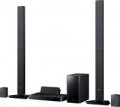Front (RMS)
Rated output of one front channel of a home theater system. This paragraph indicates the power of the complete front speaker, however, it can also be used to determine the characteristics of the built-in amplifier — its rated power on a particular channel (not necessarily the front one), usually, slightly exceeds the power of the corresponding speaker.
Rated power in this case is the highest average (root mean square, RMS) sound power that the speaker is capable of delivering for an unlimited time, working without failures and overloads. Individual signal jumps can be stronger, but the power of acoustics is determined precisely by RMS.
The
higher this indicator(regardless of whether we are talking about front or some other speakers) — the louder the speakers, the better they are suitable for large rooms. At the same time, in a small room, too high power may be unnecessary, because. operating the speaker at full volume will cause discomfort — despite the fact that powerful acoustics also have the appropriate dimensions, weight and price. More detailed recommendations on the optimal power of the speaker components, depending on the characteristics of the situation, can be found in special sources.
Rear (RMS)
Rated output of one home theater rear channel. For more information about the meaning of this parameter, see "Front" above.
Centre (RMS)
Rated power of one centre channel of a home theater. For more information about the meaning of this parameter, see "Front" above.
Subwoofer (RMS)
Rated power of the subwoofer supplied with the home theater. See "Front" above for details on power rating; here we note that subwoofers often have a fairly high power, because. they are designed to cover low frequencies in all audio channels.
Total power (RMS)
The total power rating of all home theater speakers, including subwoofers. The value of the rated power is described in detail in paragraph "Front" above.
Frequency range
The range of audio frequencies reproduced by a home theater speaker system. The wider the range — the richer the sound, the less likely it is that the acoustics will “cut off” part of the low or high frequencies. When evaluating this indicator, one should proceed from the fact that the range perceived by the average human ear is from 16 Hz to 20 kHz. However, modern home cinemas for the most part cover this range completely or almost completely.
Sensitivity
The sensitivity value determines the volume of the speaker system when an external signal of a certain power is applied to it. With the same signal strength and resistance (impedance), more sensitive acoustics provide greater volume.
Impedance
Home theater speaker system AC impedance. Impedance matters when connected to an amplifier: if the impedance of the speaker system is less than that of the amplifier, distortion in sound is possible, if it is higher, the acoustics may sound quieter than we would like. Naturally, in the original home theater sets, the speakers and amplifier are selected with the optimal impedance ratio, so in fact you only have to pay attention to this parameter when you need to connect acoustics to a “non-native” amplifier.
Front
Rated power delivered by the built-in home theater power amplifier per front channel.
Note that in home theaters the rated power of the amplifier output to any channel (any channel, not just the front one) is usually equal to the rated power of the standard speaker installed on this channel (see above). Therefore, many manufacturers do not give the characteristics of the built-in amplifier separately at all — firstly, they are easy to determine from the information about the speakers, and secondly, when using a system with complete acoustics, these data are not required. However, information about the power of the amplifier is indispensable if you plan to use third-party speakers instead of standard acoustics. The rated power of each such speaker must not be lower than the rated power on the corresponding amplifier channel — otherwise, various undesirable phenomena are possible at high volume, from sound distortion to damage to the speaker.

